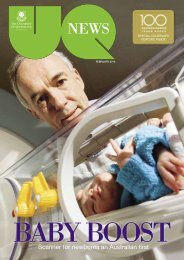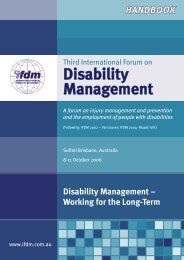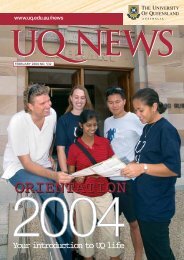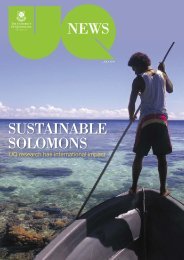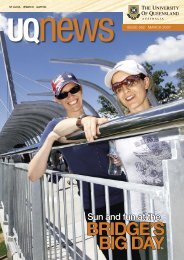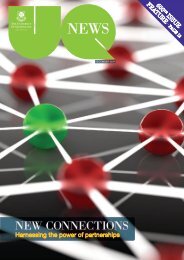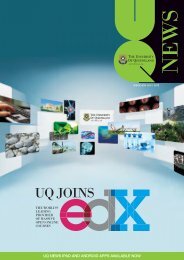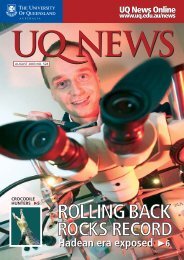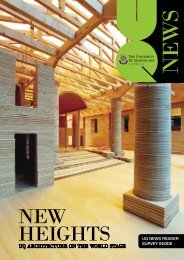Issue 581 (March 2009) - Office of Marketing and Communications
Issue 581 (March 2009) - Office of Marketing and Communications
Issue 581 (March 2009) - Office of Marketing and Communications
- No tags were found...
Create successful ePaper yourself
Turn your PDF publications into a flip-book with our unique Google optimized e-Paper software.
UQNEWS, MARCH <strong>2009</strong> ➔ 4SHORTCUTSPOP APPEALUQ research has gonebackstage to some <strong>of</strong>Australia’s biggest music festivalsto discover what makes them tick,<strong>and</strong> the answers may surprise you.Dr Nic Carah, a Lecturer withUQ’s School <strong>of</strong> Journalism <strong>and</strong>Communication, has studied the waycorporations use music festivals to helpbuild their br<strong>and</strong>s <strong>and</strong> found rather thanalienating young people, these br<strong>and</strong>ingpractices were embraced.“Global corporations have becomevery adept at co-opting popular musicculture into their marketing strategies,”Dr Carah said.“Instead <strong>of</strong> being seen as an outsider<strong>of</strong> youth culture, they gain authenticityby being part <strong>of</strong> these events.”He said while in the past some <strong>of</strong>these strategies may have been lookedupon as suspicious, young people todayunderst<strong>and</strong> the marketing practices <strong>and</strong>accept it as part <strong>of</strong> the culture.He said events such as the V Festival– a very overt br<strong>and</strong>ing exercise – areacceptable as long as there is value in itfor the concert goer.“If Virgin brings popular b<strong>and</strong>sto a festival, then the audience iscomfortable to use their phones <strong>and</strong>cameras to send texts <strong>and</strong> pictures togiant br<strong>and</strong>ed screens,” he said.“They also share these experienceson web 2.0 spaces such as MySpace<strong>and</strong> Facebook, pushing thecorporations’ reach even further.“Music events like the V festivalwork because they try to develop ameaningful <strong>and</strong> natural engagementwith the audience.”Dr Carah is working on a bookabout his research to be titled PopBr<strong>and</strong>s: br<strong>and</strong>ing, popular music <strong>and</strong>young people, which is expected to bepublished next year.STOCK.XCHNGBACTERIA BUSTINGA group <strong>of</strong> scientists in London have collaboratedwith a UQ researcher to discover a way <strong>of</strong> usingtiny nano-probes to help underst<strong>and</strong> how anantibiotic is effective against bacteria.Bacteria such as MRSA (commonly knownas Golden Staph) are becoming increasinglyresistant to antibiotics, posing a major communityhealth problem.Pr<strong>of</strong>essor Matt Cooper (pictured), has recentlyjoined the Institute for Molecular Bioscience atUQ on a $4 million Australia Fellowship.Through the fellowship, he will establish aresearch program to develop antibiotics <strong>and</strong>antifungals that are active against drug-resistantpathogens.“In order to attack this problem we need tounderst<strong>and</strong> not only the ways in which bacteriadevelop <strong>and</strong> exhibit resistance to antibiotics,but also how new antibiotics can work to kill orslow the growth <strong>of</strong> resistant bacteria,” Pr<strong>of</strong>essorCooper said.To study antibiotic action, the London teammade nano-probes coated with molecules foundREACHING FOR THE STARSQueensl<strong>and</strong> high school students recentlyreached for the stars at a UQ event toexplore the future <strong>of</strong> life in space.About 100 students from 10 differenthigh schools from throughout the state tookpart in the annual Australian Space DesignCompetition in January.Hosted by UQ’s School <strong>of</strong> InformationTechnology & Electrical Engineering (ITEE),the event involves four teams <strong>of</strong> studentsassuming it is the year 2058, <strong>and</strong> thenpreparing <strong>and</strong> presenting a tender responseto design <strong>and</strong> build a settlement in spacesuitable to accommodate up to 5000humans.ASDC chairman Mark Shaw said teamsaddressed issues in their space settlementdesign such as structural design, operationalrequirements, human factors, automation, IT<strong>and</strong> business initiatives.“The three-day competitioninvolves students from manydifferent backgrounds<strong>and</strong> schools workingcollaboratively inin bacterial cell walls from normal bacteria <strong>and</strong>bacteria resistant to antibiotics.They then added doses <strong>of</strong> the “last resort”antibiotic, vancomycin, to the system <strong>and</strong> foundthat probes from normal bacteria were stressed<strong>and</strong> changed shape, whereas probes fromresistant bacteria were only weakly affected.The team are now screening other antibioticswith the goal <strong>of</strong> finding a drug that is able tobind strongly to resistant bacteria <strong>and</strong> causesubstantial structural weaknesses to the cell wall.order to solve space settlement issues <strong>and</strong>ultimately win the chance to visit the USA<strong>and</strong> compete on an international scale,” MrShaw said.ITEE Head <strong>of</strong> School Pr<strong>of</strong>essor PaulBailes said the event allowed studentsto communicate in a group, demonstrateteamwork, work on projects <strong>and</strong> showcasetheir ideas <strong>and</strong> futuristic inventions.INSTITUTE FOR MOLECULAR BIOSCIENCEJEREMY PATTENSTOCK.XCHNG




